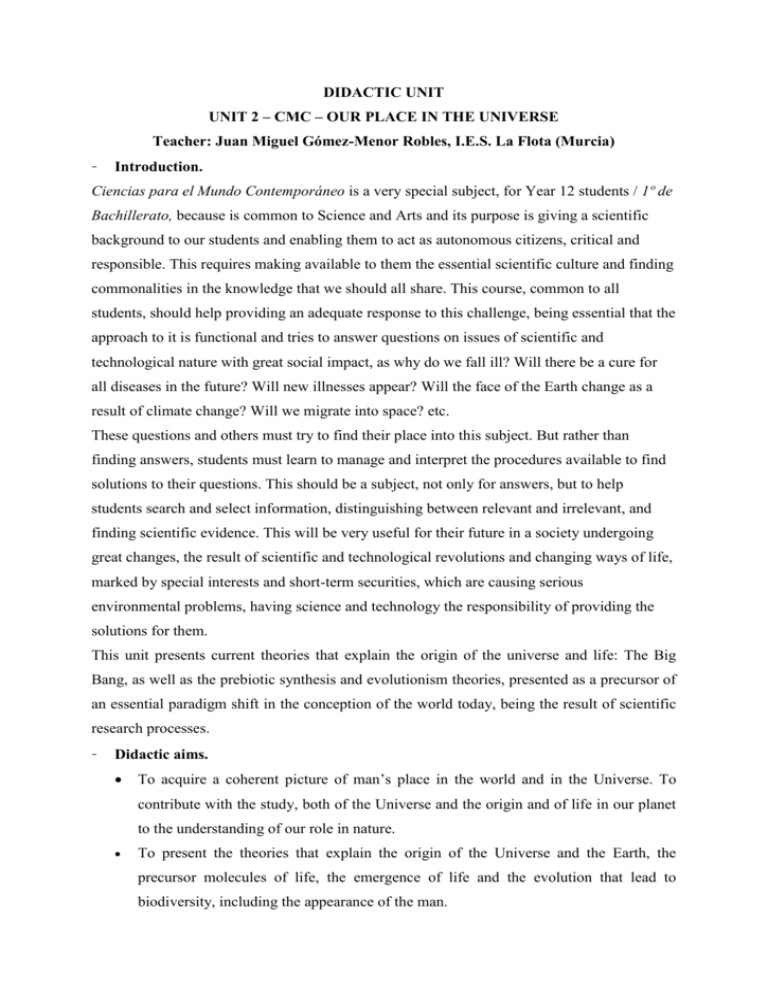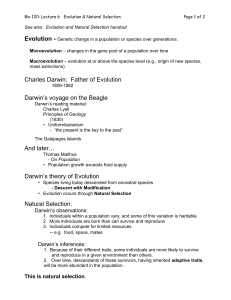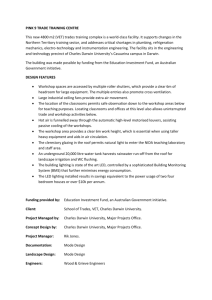
DIDACTIC UNIT
UNIT 2 – CMC – OUR PLACE IN THE UNIVERSE
Teacher: Juan Miguel Gómez-Menor Robles, I.E.S. La Flota (Murcia)
–
Introduction.
Ciencias para el Mundo Contemporáneo is a very special subject, for Year 12 students / 1º de
Bachillerato, because is common to Science and Arts and its purpose is giving a scientific
background to our students and enabling them to act as autonomous citizens, critical and
responsible. This requires making available to them the essential scientific culture and finding
commonalities in the knowledge that we should all share. This course, common to all
students, should help providing an adequate response to this challenge, being essential that the
approach to it is functional and tries to answer questions on issues of scientific and
technological nature with great social impact, as why do we fall ill? Will there be a cure for
all diseases in the future? Will new illnesses appear? Will the face of the Earth change as a
result of climate change? Will we migrate into space? etc.
These questions and others must try to find their place into this subject. But rather than
finding answers, students must learn to manage and interpret the procedures available to find
solutions to their questions. This should be a subject, not only for answers, but to help
students search and select information, distinguishing between relevant and irrelevant, and
finding scientific evidence. This will be very useful for their future in a society undergoing
great changes, the result of scientific and technological revolutions and changing ways of life,
marked by special interests and short-term securities, which are causing serious
environmental problems, having science and technology the responsibility of providing the
solutions for them.
This unit presents current theories that explain the origin of the universe and life: The Big
Bang, as well as the prebiotic synthesis and evolutionism theories, presented as a precursor of
an essential paradigm shift in the conception of the world today, being the result of scientific
research processes.
–
Didactic aims.
To acquire a coherent picture of man’s place in the world and in the Universe. To
contribute with the study, both of the Universe and the origin and of life in our planet
to the understanding of our role in nature.
To present the theories that explain the origin of the Universe and the Earth, the
precursor molecules of life, the emergence of life and the evolution that lead to
biodiversity, including the appearance of the man.
To present the processes governing the hypotheses explaining the origin of the
Universe, Solar System, Earth, life and human beings.
To reinforce the scientific paradigm of evolution as opposed to the reemerging
political-religious attitudes that favour non-scientific beliefs.
To show how natural phenomena explanations change as new scientific and
technological developments arise and as a result of them, society changes.
To show students that the knowledge of principles, laws and theories help us explain
and understand some of the fundamental problems that affect humanity, and that
social context influences decisively in the acceptance or not of those scientific
explanations.
–
Contents.
The origin of the Universe as seen by the different civilisations. Origin and evolution
theories. The origin of the elements: stardust. Exploration of the Solar System: current
situation.
Earth’s formation and layer differentiation. Lylle and the principles of geology.
Wegener’s continental drift. Global tectonics: its proofs and consequences.
The origin of life: from prebiotic synthesis to the first organisms. Main hypothesis.
From fixism to evolutionism. Main evolutionism theories. Darwin’s natural selection
and present day genetic explanation.
Our place in the biological scale. From fossil hominids to Homo sapiens. Human
species determining genetical changes.
-
Sequence of learning activities.
Each activity is an action aimed at developing a teaching unit, so every activity involves one
or more tasks performed by the students and the teacher in an organized sequence. Activities
are meant to guide learning, not a purpose in itself. The activity sequence is divided into four
types:
Initial activities are used to present the problem to the student and relate it with what
they already know and, often, to bring out his personal vision about it. Tasks can be
very different, ranging from video analysis to laboratory experiments. In this case
we’ll do the following:
o First of all, our students will undergo an exploration questioning or initial
assessment:
Since when do you think the Universe exists?
The atoms of your body, where do they come from and how where they
formed?
What makes the Earth the only planet of our Solar System that hosts
life?
How old is the Earth?
What does the word evolution mean?
Who was Darwin?
o The next thing they’ll do is watch a short (60 minutes) documentary called
“Charles Darwin and the tree of life” and fill a short questionnaire on it (1), so
that their assumed knowledge can be valued. This is a 2009 television
documentary about Charles Darwin and his revolutionary theory of evolution
through natural selection, produced by the BBC to mark the bicentenary of
Darwin's birth. The presenter, David Attenborough, outlines the development
of the theory by Darwin through his observations of animals and plants in
nature and in the domesticated state, visiting sites important in Darwin's own
life, including Down House, Cambridge University and the Natural History
Museum, and using archive footage from Attenborough's many nature
documentaries for the BBC. He reviews the development of the theory since its
beginnings, and its revolutionary impact on the way in which humans view
themselves, not as having dominion over the animals as The Bible says, but as
part of the natural world and subject to the same controlling forces that govern
all life on Earth.
Introduction: we will do a fast review of the main topics of the unit and outline its
contents, the resources and materials we are going to use and, of course, spatial and
time organization of the classes.
Core: we will go through the contents of the unit, in some cases we will do a revision
prior to the topic, considering that some of our students have studied them in 4th ESO
and others not. Some of the contents will be presented by the students – experiential
learning – being the result of workgroup research. In this unit, we usually select the
following topics (*), so that the class is divided into five groups that have to prepare a
PowerPoint or a Short Video and present it to the class (time limit 15 minutes per
group). At the end of each presentation, the group has to answer any questions posed
to them and, if needed, any part of the topic will be revised or extended by the teacher.
The students will have four sessions in the ICT classroom to do the research and
prepare the presentation. Throughout this activity, the students will be tutored by the
teacher.
(*) Topics:
The origin and evolution theories of the Universe
Exploration of the Solar System.
Earth’s formation and layer differentiation.
Wegener’s continental drift.
From fixism to evolutionism.
Extension (Optional but with Extra Score): if there is enough spare time, the
students will watch the film The Core. It is a 2003 American disaster film loosely
based on the novel Core by Paul Preuss. It concerns a team that has to drill to the
centre of the Earth and set off a series of nuclear explosions in order to restart the
rotation of Earth's core. After watching the film, we will hold a debate on it and the
students will have to write a short essay on it based on a set of questions (2), at home,
and email it or hand it to the teacher.
Plenary: one or two periods will be used to summarise the topics of the unit and draw
conclusions on each one of them.
-
Didactic resources and materials.
Types of classrooms
o Normal classroom.
o ICT Classroom with computers and overhead projector.
o Science laboratory with Interactive Whiteboard.
Audiovisual
o Compulsory
Documentary: Charles Darwin and the tree of life; 60 minutes; 2009;
BBC Natural History, Unit and Open University. Presenter: Sir David
Attenborough.
o Optional
Film: The Core; 135 minutes; 2003; Paramount Pictures; Director: Jon
Amiel.
o Recommended
Apolo XIII; 1995; Director: Ron Howard.
Contact; 1997; Director: Robert.
Man to man; 2005; Director: de Régis Wargnier.
Websites
o Compulsory
Charles Darwin and the tree of life
http://www.wellcometreeoflife.org/
o Optional
Charles Darwin and the tree of life
http://www.bbc.co.uk/programmes/b00hd5mf
http://www.open2.net/darwin/treeoflife/index.html
o Recommended
Origin of the Universe
http://science.hq.nasa.gov/universe/science/bang.html
http://www.iac.es/cosmoeduca/relatividad/guionhisto.htm
http://www.iac.es/cosmoeduca/relatividad/animaciones.htm
Hubble space telescope
http://hubble.nasa.gov
Pangea
http://piru.alexandria.ucsb.edu/collections/animations/Pangea.m
ov
Space wrights
http://www.cede.org/saludo.html
Mars exploration
http://cmex.ihmc.us/CMEX/index.html
Cassini-Huygens spacecraft
http://saturn.jpl.nasa.gov/home/index.cfm
Stanley Miller’s experiment
http://www.astrosafor.net/Huygens/2003/45/ElExperimento.htm
Great Ape Project
http://www.proyectogransimio.org
Archaeological site of Atapuerca:
www.atapuerca.com
Bibliography: the books are in Spanish, because although we recommend our
students reading them in English, but we favour success in reading comprehension.
o Altschuler, D. R. (2001): Hijos de las estrellas. Nuestro origen, evolución y
futuro. Cambridge University Press. Madrid.
o Anguita, F. (2002): Biografía de la Tierra. Historia de un planeta singular.
Aguilar. Madrid.
o Arsuaga, J. L. y Martínez, I. (2000): La especie elegida. Temas de hoy,
Madrid.
o Darwin, C. (2003): El origen de las especies. Aguazul. Barcelona.
o Darwin, C. y Wallace, A. (2006): La teoría de la evolución de las especies.
Crítica. Barcelona.
o Gould, S. J.
(2004): La estructura de la teoría de la evolución. Tusquets. Barcelona.
(2006): La vida maravillosa. Crítica. Barcelona.
o Gribbin, J. R. (2007): Biografía del Universo. Crítica. Barcelona.
o Jakosky, B. (1998): La búsqueda de vida en otros planetas. Cambridge
University Press. Madrid.
o Luque, B. y Márquez, A. (2004): Marte y vida: ciencia y ficción. Equipo
Sirius. Madrid.
o Parker, S. (2006): La raza humana: evolución. Edilupa. Madrid.
o Ruiz de Gopegui, L. (2006): Hombres en el espacio: pasado, presente y
futuro. McGraw-Hill. Madrid.
o Sagan, C. (2004): Cosmos. Planeta. Barcelona.
-
Space and time organization.
o Introduction to the topic and assumed knowledge revision.- 2 periods.
o Core.- 7 periods.
o Extension.- 1 period (if possible).
o Assessment.- 1 period.
-
Total: 11 periods.
Assessment.
o Initial assessment questionnaire.
o Charles Darwin and the Tree of Life worksheet.
o Workgroup presentation and debate.
o The Core essay (Optional / Extra Score).
o Written test.
o Difficulties and problems appreciated by the students in the unit.
(1) “Charles Darwin and the tree of life” questionnaire.
DARWIN, THE GENIUS OF EVOLUTION
ANSWER THE QUESTIONS.
REMEMBER THAT THEY ARE RELATED TO THE FILM!
1. Who is the film’s host? ……………………………………………….................
2. How many different species of flowering plants exist? ………………………...
3. Who was born 200 years ago? …………………………………………………..
4. When (year) did Darwin board the survey sailing ship named Beagle? What was his
age at the time? ………………………………………………………………….
…………………………………………………………………………………...
5. How long did the trip to Galapagos Islands last? ……………………………….
6. In which University did Darwin study geology and botany? …………………...
7. Who “invented” the term Dinosaur? …………………………………………....
8. Who founded and directed the Natural History Museum of London? ………….
…………………………………………………………………………………...
9. What was the term coined to name the process of the survival of the fittest and best
suited living beings? …………………………………………………………….
10. Which animals did Darwin use to support his theory? ………………………….
…………………………………………………………………………………...
11. From which animals do domestic dogs descend? ………………………………
12. Why can’t breeds be considered different species? …………………………….
…………………………………………………………………………………...
13. Where did Darwin conduct careful experiments with plants? ………………….
…………………………………………………………………………………...
14. Where did Darwin stop going in his latter part of his life? ……………………..
15. How many pages had Darwin’s first book published? ………………………….
16. How much money did Darwin ask his wife to invest in the publication of his book, if
he died before doing so? ……………………………………………….
17. Who sent Darwin an essay with the same ideas he had? ……………………….
18. When did he send it? ……………………………………………………………
19. Which society discussed to whom belonged the theory of evolution? …………
…………………………………………………………………………………...
20. When was Darwin’s book first published? ……………………………………..
21. Why does the film’s host consider Darwin’s book very easy to read? ………….
…………………………………………………………………………………...
22. What animal was Darwin compared to in the cartoons of his time? ……………
…………………………………………………………………………………...
23. Was Wallace a deeply religious man? …………………………………………..
24. What kind of building was the Natural History Museum compared to? ………..
…………………………………………………………………………………...
25. Is there a living bird that links birds and reptiles? What do they have – when young –
that is astounding? ……………………………………………………..
…………………………………………………………………………………...
26. Which is the most primitive living mammal? …………………………………..
27. What woman discovered radioactivity that is used to determine the age of rocks?
…………………………………………………………………………...
28. Why can’t frogs survive in sea water? ………………………………………….
…………………………………………………………………………………...
29. When did a German geologist propose that a super-continent had existed many million
years ago? Do you know his name? …………………………………………….
…………………………………………………………………………………...
30. What scientist was living in the city of Brno and working with peas at the same time
that Darwin was developing his theory? ………………………………………..
31. When and where was the purpose of genes discovered? ……………………….
…………………………………………………………………………………...
32. What scientists discovered its purpose and structure? ………………………….
…………………………………………………………………………………...
33. Do genes from an animal work in another? Give an example. …………………
…………………………………………………………………………………...
34. Which animals are kangaroos related to? ……………………………………….
35. From which animals did sea-cows evolve? ……………………………………..
36. When did the dinosaurs become extinct? ……………………………………….
37. Did a group of dinosaurs survive and in which group of living creatures have they
evolved? ……………………………………………………………………
38. When did the first mammal appear? ……………………………………………
…………………………………………………………………………………...
(2) The Core (2003)
Good Science and Bad Science in the Movie
Sample Essay Questions that can be used in science classes when showing the movie.
Teachers who want to use the .Pdf version with your classes! Please save the file to your hard
drive instead of having your students open the large "Geolor.com" .Pdf file every time you
want a student to access the document.
If you are a teacher who posts assignments on a web site and you would like your students to
complete an independent assignment using this document, please link to this online .Html
page rather than to the Adobe Acrobat .Pdf version.
This will save on the daily bandwidth used on this domain and your compliance will be
greatly appreciated.
The following essay questions support viewing of The Core movie.
Students may want to watch the movie at home then consider answering one or more for
SCIENCE EXTRA SCORE. Check with Mr Gómez-Menor.
1. State one geological concept that is true but which was distorted in the film for
entertainment purposes. Be sure to explain in what ways the truth was changed into fiction.
2. Explain why it would be highly unlikely that the terranauts could travel through a void
(empty space) in the Earth's mantle.
3. In the movie magnificent, huge Quartz crystals inside a large "mantle geode" were a
dangerous encounter for the terranauts. Explain first why this geode would not have existed in
Earth's mantle and second, why quartz crystals would also not have been present in the
mantle.
4. Why would temperatures and pressures inside the Earth's mantle and cores prohibit
subterranean travel to the Mantle-Core Interface?. Refer to specific data on the following
reference chart to support your answer: Inferred Properties of Earth's Interior.
5. What is the Earth's Magnetic Field? How is it generated? In what ways does it protect
Earth? Is it alone responsible for shielding earth's inhabitants from harmful solar radiation? If
not, what other factor assists in protecting living organisms from sun energy?
6. State a line from the movie that is an outright scientific error. There are at least 2. Who said
it and why is the quote scientifically incorrect?
7. Provide details concerning the physical characteristics of Earth's Outer Core. What is it
like? What does it do? What is its composition? Exactly where is its location inside Earth?
Consult the following reference chart for useful details: Inferred Properties of Earth's
Interior.
8. What is High Altitude Static Discharge and what is one gorgeous celestial phenomenon
resulting from this effect?
9. Virgil entered the Earth at the Mariana Trench and exited via a "space between 2 tectonic
plates somewhere near Hawaii". If you were the film's producer, why you would have chosen
these 2 locations as the entry and exit points for Virgil? If you were a scientist critiquing the
movie, comment on the choice of these 2 locations, supporting your response with scientific
facts.
10. Write about how changes in the Earth's Magnetic Field affected people and animals on
Earth, as depicted in the movie. Give at least 2 examples. Be specific then add your own
scientific commentary as to which of these details was distorted and how?
The Core, Good Science and Bad Science in the Movie - Sample Student Essays
was written by and is © L. Immoor, Geolor.com, Geoteach.com 2006
All Rights Reserved
08, October, 2006
L. Immoor BA, MA
Hofstra University
After watching the film and answering the questions, it is advisable to read and discuss the
document related with the previous questionnaire (The Core Good Science and Bad Science
in the Movie).









